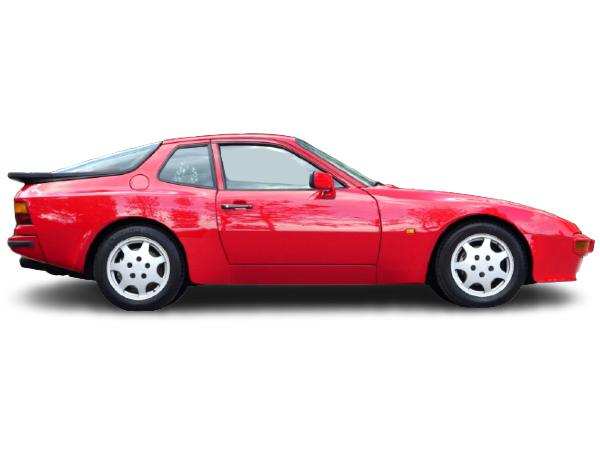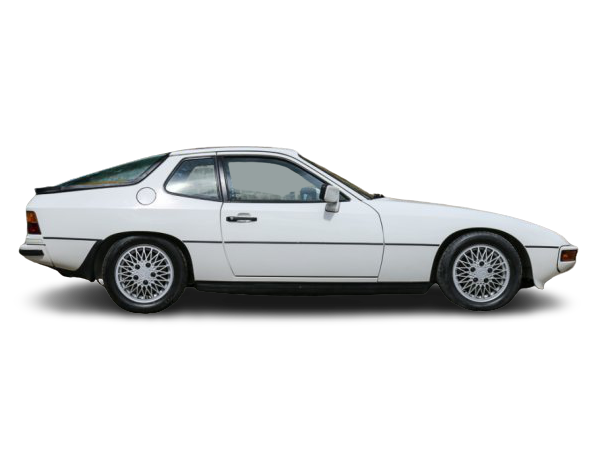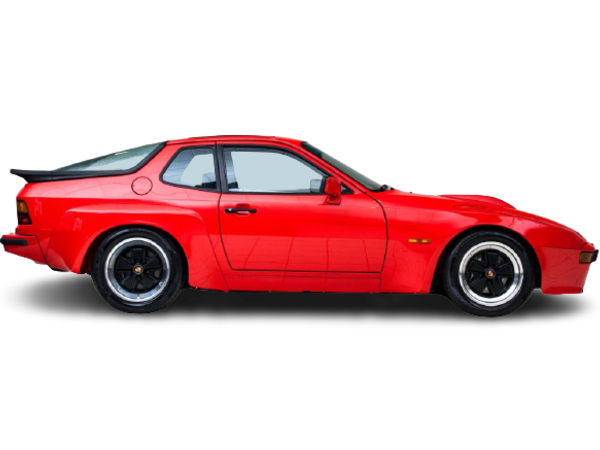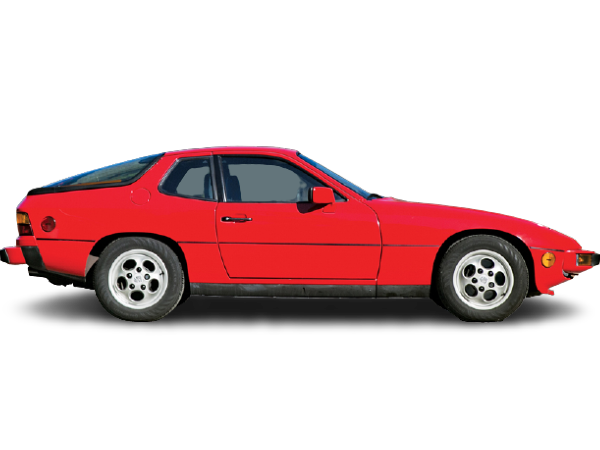The Porsche 924 Story
The need for an affordable Porsche
Full Story / Model Guides / Research & Data / Timeline & Evolution / Performance / Videos & Pics / FAQs / News
Manufacturer: Porsche AG
Production Years: 1976–1988
Production: 152,082 units
Designer: Harm Lagaay
Body style: 2-door 2+2 hatchback/fastback
Layout: Front-engine, RWD
Engines: 2.0 L VW EA831 Inline 4, 2.0 L Turbo VW EA831 Inline 4, 2.5 L Porsche M44/40 Inline 4
Transmissions: 4 spd manual, 5-spd manual
Length: 4,200 mm (165.4 in)
Width: 1,685 mm (66.3 in)
Height: 1,270 mm (50.0 in)
Kerb weight: 1,080 kg (2,381 lb)
Premiere: Unveiled on Nov 15 1975
The 924 originated as a contract design by Porsche for Volkswagen, based mainly on readily available parts from the VW parts bin. VW chose to cancel plans late in the project for financial reasons. Porsche then bought the rights to the design and produced the car, having VW assemble the cars at its Audi plant in Neckarsulm. Initial configuration was a 2.0L inline-4 SOHC engine with solid front disc and rear drum brakes. Porsche then proceeded through a series of upgrades to improve the performance of the car to meet the public's expectations of Porsche performance. Upgrades involved better brakes, optional sport suspension, 5-speed transmissions, and more power for the engine. Comfort and convenience upgrades included the addition of AC, power windows, power mirrors and better stereo. Other steps were taken by Porsche to try to improve the car's appeal in the market, starting with special editions such as the Martini Edition in 1977, the Limited Edition in 1978 and the Sebring edition in 1979.
The real boost in performance the 924 needed was achieved with the release of the 924 Turbo, also known as the 931, in late 1979. Compression was reduced slightly from the 924 to handle the boost, and a new head was implemented with better flow characteristics. Boost levels were moderate, 8-10psi. The engine was fitted with an oil cooler for durability. The 931 came with a 5-speed transmission from the start, but had the early-style disc/drum brakes. It became clear that the increased performance of the 931 needed the better, later, optional 4-wheel vented disc brakes. Later versions of the 931 received improved digital ignition systems.
In 1981 the 924 Carrera GT was released, known as the 937. Cosmetically, it foreshadowed the 944, with a wide front end to cover the wider track, but the rear width was strictly increased through the use of small add-on flares, as seen currently on the 911 GT2 cars. The extra bodywork was all plastic, not fiberglass. The better brakes were standard, but with slightly different brake circuitry due to the different suspension geometry. 16" Fuchs rims and upgraded suspension and brakes were standard. The engine made substantially more power than the 931 thanks to an intercooler, higher boost, and lower compression. The intercooler was mounted integral to the charge tube going from the turbo to the throttle body, right over the cam cover, to minimize turbo lag. However, getting airflow to this location was difficult, and resulted in the scoop on the hood over the cam cover. Only 406 of these were made, and none officially imported to the US, though a handful made it in through private importers (grey-market).
Later on the Carrera GTS and GTR were released. These were not referred to by distinct model numbers, as they were developed from the 937 Carrera GT, and so are also considered 937's. They were, by contrast with the other models, built at Porsche in Zuffenhausen. The GTS had an intercooler in the nose, as later reused in the 944 Turbo, with fixed headlights behind plexiglass covers forced by removal of the headlight linkage to accommodate the intercooler ducting. Weight was lowered and power improved, but the car was still street-legal, at least in Europe. 59 GTS's were made, with 15 in Club Sport configuration - further weight-reductions, rollcage, etc. The GTR was a pure racecar, developed for the endurance races of LeMans, Sebring, and the like, making 375bhp and beyond, and weighing even less. Every detail of the cars were heavily modified for racing, especially the suspension, with plenty of details for endurance racing, like air jacks, dry-break fuel cell refueling, etc. The roll cages were particularly neat, being constructed of welded alloy, well gusseted and bolting into the car's body at 14 points. A matching strut tower brace added further stiffening in front of the firewall. The intercooler for the GTR was much larger besides than the GTS, but also located in the nose of the car. Only 18 GTR's were constructed.
This graphic breaks out the Porsche 924 in terms of timelines and how to tell all the models apart. Click on the image to see it in higher definition. We have broken out the models by region, model, engine and even fuel injection type as well as transmissions available and anything else pertinent.

The 924 was imported into the US with a 2.0 liter engine until 1982. The production of the 2.0 liter engine, with the cast iron block, and aluminum alloy pan and head, continued till 1985, the last year the 924 was sold in Europe. The 924 was originally equipped with a four-speed gear box, while a five-speed gearbox and an automatic option were available in later years. Some cars in the intervening years were produced with the 016Z Audi five-speed transmission, which had the inverted (‘German’) gear-shift pattern. In 1986, the 2.5 liter aluminum block engine and drive train from the 944 were transplanted into the 924 body, and sold as the 924S. Except for visual similarity with the 924, such as the bodywork and the round side marker lights, this is a very different car when it comes to performance, maintenance and upkeep.

Porsche upgraded the performance of its 924 with the introduction of a turbocharged model in 1979. While the lower end of the engine remained unchanged, many improvements were made to the upper end of the engine as well as the drivetrain. On the outside, the car gained alloy wheels, a distinctive NACA duct in its hood, and a rear spoiler. Horsepower increased from the aspiro's 125 bhp to 170 bhp in the turbo. This car's internal project number at Porsche was "931", and for that reason many owners refer to their car that as a 931.

In 1981 the 924 Carrera GT was released, the hot-rodded 931, also known as the 937. Cosmetically, it foreshadowed the 944, with a wide front end to cover the wider track, but the rear width was strictly increased through the use of small add-on flares, as seen currently on the 911 GT2 cars. The extra bodywork was all plastic, not fiberglass. The better brakes were standard, but with slightly different brake circuitry due to the different suspension geometry. 16" Fuchs rims and upgraded suspension and brakes were standard. The engine made substantially more power than the 931 thanks to an intercooler, higher boost, and lower compression. The intercooler was mounted integral to the charge tube going from the turbo to the throttle body, right over the cam cover, to minimize turbo lag. However, getting airflow to this location was difficult, and resulted in the scoop on the hood over the cam cover. Only 406 of these were made, and none officially imported to the US, though a handful made it in through private importers (grey-market).

Fifty-five copies of the GTS were produced, of which some smaller number were Club Sport variants destined for competition. The latter included an aluminum roll cage made by Matter. Horsepower was again increased, this time to 245 bhp. These were not referred to by distinct model numbers, as they were developed from the 937 Carrera GT, and so are also considered 937's. They were, by contrast with the other models, built at Porsche in Zuffenhausen. The GTS had an intercooler in the nose, as later reused in the 944 Turbo, with fixed headlights behind plexiglass covers forced by removal of the headlight linkage to accommodate the intercooler ducting. Weight was lowered and power improved, but the car was still street-legal, at least in Europe. 59 GTS's were made, with 15 in Club Sport configuration - further weight-reductions, rollcage, etc.

In 1984, VW decided to stop manufacturing the engine blocks used in the 2.0 L 924, leaving Porsche with a predicament. The 924 was considerably cheaper than its 944 stablemate, and dropping the model left Porsche without an affordable entry-level option. The decision was made to equip the narrower bodied 924 with a slightly detuned version of the 944's 163 bhp 2.5 litre straight four, upgrading the suspension and adding 5 lug wheels and 944 style brakes, but retaining the 924's early interior. The result was 1986's 150 bhp 924S. Porsche also decided to re-introduce the 924 to the American market with an initial price tag of under $20,000. The 1988 model got a power increase to 160 hp, making it slightly faster than the base 944 thanks to it's lighter weight.
Below we take a look at the performance and specifications for the core production model Porsche 924s.
For those who want to see the Porsche 924 in all its glory, our Porsche 924 Pictures, Galleries & Wallpapers section features a stunning collection of high-quality images, including factory photos, rare color options, historical advertisements, and downloadable wallpapers for enthusiasts.
Experience and enjoy the fabulous Porsche 924 in these fun videos we curated from across the internet.
The most frequently asked questions from readers about the Porsche 924.
The Porsche 924 has long been one of the most accessible entry points into classic Porsche ownership, though its values have been on the rise in recent years as enthusiasts begin to appreciate its unique place in the brand’s history. For standard models built between 1976 and 1982, prices remain relatively modest. Project cars or non-running examples can still be found for as little as $2,000 to $5,000, while clean, running driver-quality cars typically range from $6,000 to $12,000. Well-preserved or fully restored examples can push into the $15,000 to $20,000 range, especially if they have low mileage and original paint.
The more powerful 924 Turbo (931) commands a premium due to its performance and relative rarity. Expect prices for decent examples to start around $8,000, with good condition cars landing between $15,000 and $22,000. Exceptional examples — low-mileage, well-documented, or concours-restored — can reach $25,000 or more. These turbocharged variants offer significantly improved performance over the base models and are increasingly sought after by collectors looking for under-the-radar classics.
At the top of the 924 hierarchy sits the Carrera GT, a rare homologation special produced in very limited numbers — only around 400 units were built. With aggressive bodywork, serious performance, and true motorsport pedigree, the Carrera GT is now a genuine collector’s item. Values for these cars start around $75,000 and can climb past $125,000 depending on condition, history, and originality.
As the air-cooled Porsche market continues to climb, more enthusiasts are turning to transaxle cars like the 924 for their analog driving experience and retro charm. While they were once overlooked, clean and unmodified 924s — especially Turbos and Carrera GTs — are becoming increasingly appreciated in the classic car world.
The horsepower output of a Porsche 924 varies depending on the model and year, as Porsche made several updates over the car’s production run. The original 924, introduced in 1976, was powered by a 2.0-liter inline-four engine that produced around 95 horsepower for U.S.-spec models, and approximately 110 horsepower for European versions. This engine was sourced from Audi and Volkswagen, and while not particularly powerful, it delivered respectable performance for a lightweight sports coupe of the era. With its near-perfect weight distribution thanks to the front-engine, rear-transaxle layout, the car was more about balance and handling than outright speed.
In 1979, Porsche introduced the 924 Turbo (internally designated as 931) to address criticisms of the base car’s modest performance. The turbocharged 2.0-liter engine significantly improved the power output, producing 143 horsepower in early European models and around 150 horsepower in later versions. U.S.-spec Turbo models were initially detuned to about 143 horsepower, but later updates brought them closer in line with European counterparts. The Turbo variant transformed the 924 into a much more capable and exciting sports car, offering a genuine performance upgrade while retaining the 924's handling characteristics.
There was also the ultra-rare 924 Carrera GT, developed in 1980 as a homologation special for motorsports. This model featured a heavily reworked version of the turbocharged engine, now producing 210 horsepower, which gave it serious performance credentials. With a wider track, aggressive bodywork, and improved suspension, the Carrera GT showcased the full potential of the 924 platform. It’s considered the pinnacle of the 924 series and one of the most collectible transaxle Porsches ever made.
So, depending on the variant, a Porsche 924 could have anywhere from 95 to 210 horsepower, with the driving experience ranging from economical and nimble to legitimately quick and motorsport-inspired.
The original base 924, produced from 1976 through the early 1980s, wasn't built for outright speed. U.S.-spec models, with just 95 horsepower, took around 11 to 12 seconds to reach 60 mph. European versions were slightly quicker thanks to their higher output (about 110 horsepower), managing the sprint in roughly 9.5 to 10 seconds. While those numbers might not sound impressive today, the car's lightweight build and excellent handling made it feel more agile than its raw acceleration figures suggested.
With the introduction of the 924 Turbo (931) in 1979, performance improved significantly. Early models could hit 60 mph in about 7.5 to 8.0 seconds, depending on tuning and the market. Later versions, especially the upgraded post-1981 models with improved engine internals and slightly more power (up to 150 hp), could manage it in as little as 7.0 seconds, making the Turbo a genuinely quick car for its time.
The high-performance 924 Carrera GT, with 210 horsepower, pushed acceleration into a different league. It could go from 0 to 60 mph in just 6.5 seconds, putting it in the same conversation as some of the more powerful sports cars of the early 1980s. Combined with its aggressive styling and racing pedigree, the Carrera GT was the most dynamic and fastest member of the 924 family.
In summary, 0–60 mph times for the Porsche 924 range from around 12 seconds for early base models to 6.5 seconds for the rare Carrera GT, reflecting the model’s diverse performance spectrum over its production life.
When it comes to picking the “best year” for a Porsche 924, the answer depends on what you're looking for—whether it’s performance, collectibility, reliability, or historical significance. That said, a few standout years rise to the top depending on your priorities:
For collectors and enthusiasts seeking the ultimate 924, 1980 is the crown jewel. That’s the year Porsche introduced the 924 Carrera GT, a limited-production homologation model built to allow Porsche to compete in Group 4 racing. It featured flared arches, upgraded suspension, a more aggressive body kit, and a turbocharged engine pushing out 210 horsepower. With only around 400 units made, it's incredibly rare, highly collectible, and a genuine performance machine—making 1980 arguably the best year for the 924 in terms of legacy and desirability.
If you're after a fast and drivable 924, then the later Turbo models (Series 2) from 1981–1982 are excellent choices. Porsche improved reliability and performance over the earlier 1979–1980 Turbos, including a revised cylinder head, better fuel injection, and a more robust engine block. These cars had around 150 horsepower, improved turbo response, and better refinement, making them more enjoyable as both weekend and occasional daily drivers.
For budget-conscious buyers or those who appreciate simplicity, 1977–1978 models represent the best value. They lack the complexity of the later Turbo models, and being early in the production run, they still retain the clean, original design and analog Porsche feel. Plus, many of these earlier cars are now considered vintage and are gaining traction among entry-level classic Porsche enthusiasts.
Best Overall (Performance + Collectibility): 1980 Carrera GT
Best Turbocharged Driver’s Car: 1981–1982 924 Turbo (Series 2)
Best Budget Classic: 1977–1978 base 924
The Porsche 924 has historically been one of the most affordable classic Porsches, and while values have been rising lately, it’s still considered “cheap” compared to its siblings like the 911 or even the 944. There are a few key reasons for this:
One of the biggest knocks against the 924—especially among Porsche purists—is that its original engine was sourced from Audi/Volkswagen. The 2.0-liter inline-four used in early models was originally designed for the VW LT van and Audi 100. While it was reliable and efficient, it didn’t deliver the kind of performance or sound that people typically associate with the Porsche name. That perception of being “not a real Porsche” stuck for years, especially in comparison to the iconic 911.
The early U.S.-spec 924s only made around 95 horsepower, which even by 1970s standards was underwhelming. Though the car had great balance and handled very well thanks to its transaxle layout, its straight-line performance couldn’t match the muscle cars or higher-end sports cars of the time. As a result, it gained a reputation as a “slow Porsche,” which lingered in the minds of enthusiasts and buyers.
Because it was marketed as Porsche’s entry-level car, the 924 was often bought by first-time sports car owners or drivers who weren’t necessarily Porsche fanatics. That led to many cars being poorly maintained or modified over the years, especially as values dropped. The association with being “the cheap Porsche” made it less desirable for collectors—until recently.
Although they’re inexpensive to buy, 924s still require Porsche-level maintenance in many areas—especially the Turbo and Carrera GT variants. For a long time, it didn’t make economic sense to spend thousands restoring or maintaining a car that was only worth a few grand. That kept supply of truly nice examples low and values stagnant.
Tastes are starting to shift, though. As air-cooled 911s and 944 Turbos become increasingly expensive, people are beginning to appreciate the 924’s lightweight chassis, clean design, and analog driving experience. The once-dismissed transaxle platform is gaining recognition for its balance and engineering. As a result, the best examples—especially 924 Turbos and Carrera GTs—are climbing in value.
In short: the 924 was “cheap” because of its modest performance, VW/Audi roots, and decades of being overshadowed. But today, it’s being rediscovered as a hidden gem—one that offers a pure, balanced driving experience with vintage Porsche charm at a still-reasonable price.
Porsche produced a total of approximately 150,684 units of the Porsche 924 across all variants from 1976 to 1988. Here's a breakdown of the major production numbers by model:
Approx. 121,000 units
These included the original base models with the 2.0-liter Audi-sourced engine.
Most were built for the European market, with a sizable number exported to North America.
Approx. 13,616 units
This includes both early and late-series 924 Turbos.
Offered better performance and Porsche-developed enhancements over the base model.
924 Carrera GT: Approx. 406 units
924 Carrera GTS: Approx. 59 units
924 Carrera GTR (race cars): Approx. 17 units
These were built primarily for homologation and motorsport purposes and are extremely rare today.
Approx. 16,669 units
The 924S marked a return to the 924 body style but used the Porsche-designed 2.5L engine from the 944.
It offered better performance and was seen as a more “authentic” Porsche.
Approximately 150,684 units
The Porsche 924S is special because it represents a unique blend of two Porsche worlds: the accessible, lightweight charm of the original 924 and the mechanical excellence of the more powerful 944. Produced from 1986 to 1988, the 924S was Porsche’s way of reviving the 924 platform by finally giving it a true Porsche engine, and in doing so, it gave the car the performance and pedigree many enthusiasts had been craving since the 924’s debut.
What truly set the 924S apart was its engine. Unlike the early 924s that used a 2.0L inline-four sourced from Audi, the 924S got the 2.5L inline-four engine from the Porsche 944, albeit in slightly detuned form. Initially producing around 147 horsepower (and later up to 160 hp in 1988), the 924S had real sports car punch while maintaining the original 924's light weight and nimble chassis. This combination gave it impressive performance—especially considering its price point—with 0–60 mph times in the low 7-second range.
Because the 924S retained the original 924’s smaller body and lighter frame while gaining the 944’s engine and upgraded suspension, it achieved a near-perfect balance. The front-engine, rear-transaxle layout gave it excellent weight distribution, and many enthusiasts argue the 924S is even more fun to drive than the 944, thanks to its lighter, more tossable nature.
At the time—and even today—the 924S offered an affordable entry point into Porsche ownership without compromising on quality or driving experience. It was a return to form for the 924 series, finally silencing some critics who dismissed the original as “not a real Porsche.” It delivered genuine sports car performance, Porsche build quality, and classic transaxle charm—all at a reasonable price.
Though often overshadowed by the 944 and 911, the 924S is now recognized by enthusiasts as an underrated gem. It marked the last hurrah for the 924 platform and did so with a proper Porsche heart. Today, it’s a great choice for those who want a vintage Porsche driving experience that’s both rewarding and relatively affordable to own.
In short, the 924S was special because it gave the 924 the performance and Porsche DNA it always deserved—combining light weight, great balance, and proper Porsche power in one sleek package.
Join Our Porsche Community
Sign up for our weekly Porsche newsletter. The latest Porsche news, rumors, reviews and more delivered to your inbox. Cool Porsche stuff perfect for the flat-six obsessed.